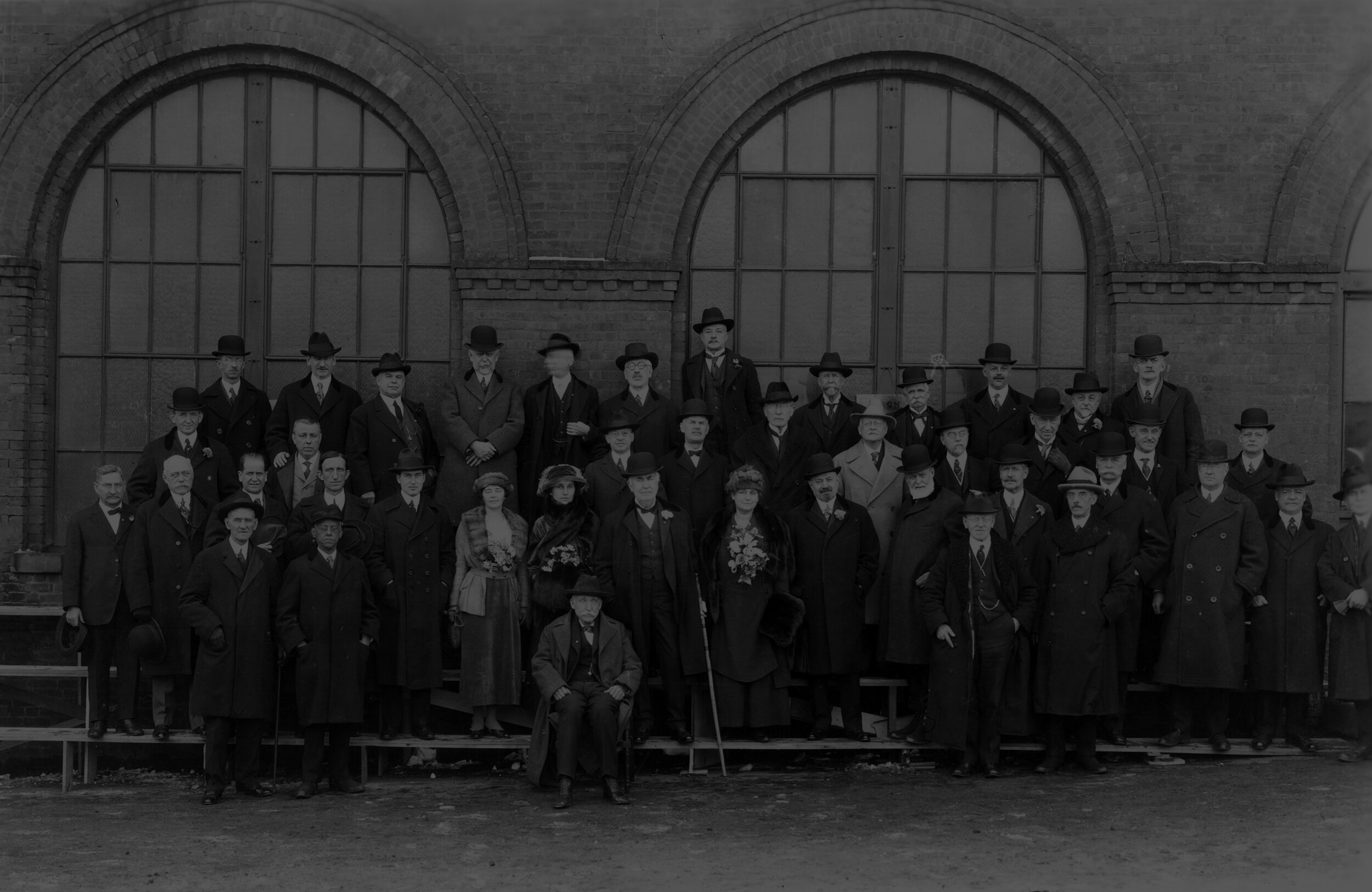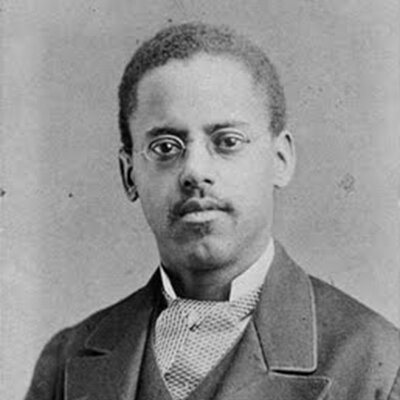
History
Lewis Howard Latimer
Biography
Lewis Howard Latimer
September 4, 1848 – December 11, 1928
Early Life
Lewis Howard Latimer was born on September 4th, 1848 in Chelsea, Massachusetts. His parents were self-emancipated enslaved Virginians. Growing up, Latimer faced many challenges due to racial discrimination prevalent at the time. He enlisted in the Union Navy in 1864 at the age of 16 and –with no access to formal education– taught himself mechanical drawing. Eventually, he became a chief draftsman, patent expert, and inventor.
The Edison Pioneers in 1920. Latimer is in the first row, second from the left (standing in front of the risers) and Edison is standing in the center of the first row, holding a walking stick. The photo is from The Latimer-Norman Family Collection.
Personal Life
In 1873, Latimer married Mary Wilson in Fall River, Massachusetts, and they had two daughters. The family were active members of the Unitarian Church, and Latimer was very involved in Civil War veteran groups like the Grand Army of the Republic. He was a prominent member of the African American community and worked to promote the education and advancement of Black people. Latimer even taught English and mechanical drawing to recent immigrants at the Henry Street Settlement in New York. He was a “Renaissance man,” writing poems and plays, playing the flute, and was passionate about visual arts. Some products of his artistic endeavors can be viewed at the Lewis Latimer House Museum.
Career
After serving in the Union Navy during the Civil War, Latimer leveraged his self-taught drafting skills to land a job at a patent law firm in Boston as a draftsman. There he worked on many important inventions, including the development of the telephone alongside Alexander Graham Bell. Latimer helped to develop a more efficient transmitter that improved the quality of the sound, and his drawings were crucial for securing the telephone patent.
Latimer also worked with Thomas Alva Edison on the development and commercialization of the incandescent light bulb. He designed a longer-lasting filament, making electric lighting more practical and affordable. Furthermore, Latimer worked with Hiram S. Maxim, significantly improving the production of carbon filament.
In addition to helping others, Latimer designed his own inventions including an early air conditioning unit and an improved railroad car bathroom. In total, the United States government awarded him patents for seven of his own inventions.
Impact and Legacy
Lewis Latimer died on December 11, 1928 at the age of 80 in Flushing, Queens, New York.
Despite the economic and social challenges he faced, he was a pioneer in the field of technology, who made important contributions such as the lightbulb and the telephone, which continue to shape modern life.
Latimer is a symbol of perseverance and his contributions and advocacy for education and equal rights have had a meaningful and long-lasting impact.
Frequently Asked Questions
-
Lewis Howard Latimer was the son of self-emancipated enslaved people, a self-taught draftsman, and contributed to the invention of the lightbulb and the telephone. Some of his own inventions are the early air conditioning unit and the railroad car bathroom.
-
Lewis Howard Latimer was an African American inventor, draftsman, and engineer who made important contributions to science and technology which continue to affect modern life.
-
Lewis Howard Latimer developed improvements to the telephone, a longer-lasting filament for the incandescent light bulb, and an early version of the air conditioner – among other inventions.
-
Like any invention, the lightbulb was developed over time by teams of experts through multiple evolutions. Lewis Howard Latimer made significant contributions to the incandescent lightbulb, working with Hiram Maxim and Thomas Alva Edison on the development and commercialization by designing a longer-lasting filament to make electric lighting more practical and affordable.
-
Not exactly, but Lewis Howard Latimer worked alongside Alexander Graham Bell to develop it. Latimer’s drawings were crucial for the patent of the telephone, and he helped to develop a more efficient transmitter that improved the quality of the sound.
-
Lewis Howard Latimer joined the United States Navy when he was 16 years old and served as a landsman on the USS Massasoit. After two years, he received an honorable discharge and remained patriotic. He was secretary and adjutant in the Grand Army of the Republic, a veteran organization.
-
Lewis Howard Latimer was born and raised in Chelsea, Massachusetts; he worked in Boston, Massachusetts for some years; and he also lived in Bridgeport, Connecticut with his wife.
From 1903 until his death at the age of 80 in 1928, he lived with his family on Holly Avenue, which is now known as the East Flushing section of Queens, New York. Today, Latimer’s final residence is a historic house museum that functions as a public, cultural institutional institution that provides primary research materials dedicated to Latimer’s legacy and that of other innovators of color.
-
Lewis Howard Latimer married Mary Wilson Lewis in 1873 and they had two daughters - Emma Jeanette Latimer and Louise Rebecca Latimer.
-
Lewis Howard Latimer continues to be an inspiration for members of the African-American community to pursue careers in science and technology, and he was an advocate for education and equal rights
-
Lewis Howard Latimer was a vocal advocate for education and equal rights. He also served as a role model and inspiration for generations of African-American scientists and inventors, and his legacy continues to motivate leaders in the fight for social justice.
-
Lewis Howard Latimer’s example shows the importance of diversity and inclusion in science and engineering, and his innovations continue to inspire new generations. His story also shows the importance of determination and perseverance when faced with adversity and challenges.
Citations:
Innovative lives: Lewis Latimer (1848-1928): Renaissance man. Lemelson Center for the Study of Invention and Innovation. (2018, February 7). https://invention.si.edu/innovative-lives-lewis-latimer-1848-1928-renaissance-man
Lewis Howard Latimer. Biography.com. (2021, January 7) https://www.biography.com/inventors/lewis-howard-latimer
Lewis Latimer House Museum
The Lewis Latimer House Museum is a Landmarked home, Queen Anne-style, wood-frame suburban residence constructed between 1887 and 1889 by the Sexton family. Lewis Howard Latimer lived in the house from 1903 until his death in 1928. The house remained in the Latimer family until 1963. Threatened with demolition, the house was moved from Holly Avenue to its present location in 1988.
Today, the Museum is a fully functional public, cultural institution that provides primary research materials dedicated to Latimer’s legacy and that of other innovators of color.
The Lewis Latimer House is owned by the New York City Department of Parks & Recreation, operated by the Lewis H. Latimer Fund, Inc., and is a member of the Historic House Trust.





